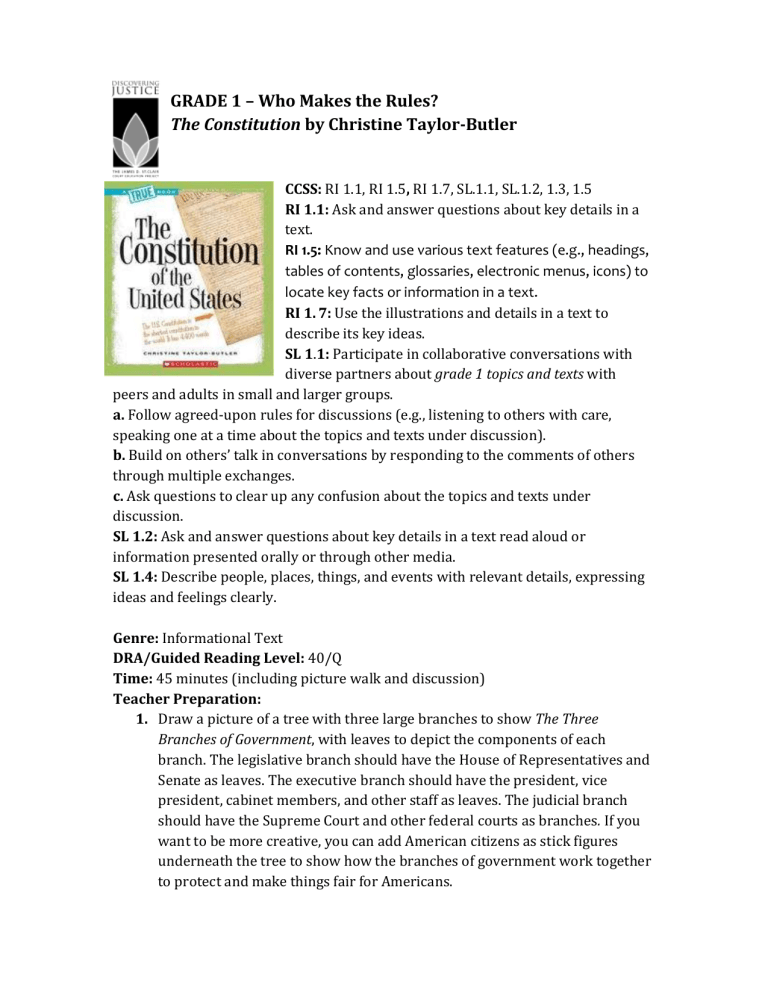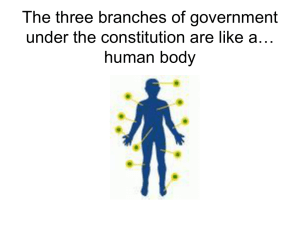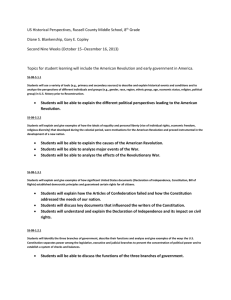Grade 1_The Constitution picture walk

GRADE 1 – Who Makes the Rules?
The Constitution by Christine Taylor-Butler
CCSS: RI 1.1, RI 1.5, RI 1.7, SL.1.1, SL.1.2, 1.3, 1.5
RI 1.1: Ask and answer questions about key details in a text.
RI 1.5: Know and use various text features (e.g., headings, tables of contents, glossaries, electronic menus, icons) to locate key facts or information in a text.
RI 1.
7: Use the illustrations and details in a text to describe its key ideas.
SL 1.1: Participate in collaborative conversations with diverse partners about grade 1 topics and texts with peers and adults in small and larger groups.
a. Follow agreed-upon rules for discussions (e.g., listening to others with care, speaking one at a time about the topics and texts under discussion).
b. Build on others’ talk in conversations by responding to the comments of others through multiple exchanges.
c. Ask questions to clear up any confusion about the topics and texts under discussion.
SL 1.2: Ask and answer questions about key details in a text read aloud or information presented orally or through other media.
SL 1.4: Describe people, places, things, and events with relevant details, expressing ideas and feelings clearly.
Genre: Informational Text
DRA/Guided Reading Level: 40/Q
Time: 45 minutes (including picture walk and discussion)
Teacher Preparation:
1.
Draw a picture of a tree with three large branches to show The Three
Branches of Government, with leaves to depict the components of each branch. The legislative branch should have the House of Representatives and
Senate as leaves. The executive branch should have the president, vice president, cabinet members, and other staff as leaves. The judicial branch should have the Supreme Court and other federal courts as branches. If you want to be more creative, you can add American citizens as stick figures underneath the tree to show how the branches of government work together to protect and make things fair for Americans.
2.
Display a wall map of the United States.
Picture Walk
Note: The symbol indicates suggested language for sharing this book aloud with your students. You know your students best and should feel free to alter what you say in any way that works for your group.
Turn to the picture on p. 6.
The Constitution, the set of rules that America follows, is actually very short: a one-page scroll. It is very short because it gives only general guidelines for our rules/laws. All of the laws written in our country have to follow these guidelines.
Turn to the picture on p. 9, and read the caption.
When the Constitution was written, New York City was the capital of our country.
Show students where New York City is on the wall map.
Q: What is the capital of our country today?
Have a student point it out on the map. Provide support, if necessary.
Q: Do you know where we are on this map?
Help students identify your city/town on the map.
Turn to the picture on p. 14 and read the caption.
A long time ago, America fought a war to become its own country and make its own laws.
Turn to the pictures on pp. 18–19.
These are pictures of some of the leaders who wrote our Constitution.
Read the names of these delegates aloud.
At this time, in 1787, women, African Americans, and Native Americans were not invited to work on the Constitution. Even though the leaders were trying to make fair rules and laws, things weren’t fair for everyone yet.
Turn to p. 21.
The writers of the Constitution came to Philadelphia to meet because it was not too far from any of the 13 states.
Show students where Philadelphia is on the wall map.
Turn to the picture of a young George Washington on p. 23.
George Washington was America’s leader when America fought against England.
Many people thought George Washington would make a good first president because he had been the American leader in the war against England.
You may want to show pictures of George Washington on the one-dollar bill, the quarter, and Mt. Rushmore. You may also want to list places and references to
George Washington: Washington, D.C. and the state of Washington (and explain the difference between the two).
Turn to the picture on p. 24, and read the caption.
It took 16 weeks to write the Constitution. There are about four weeks in a month. How many months is 16 weeks? Make a comparison in reference to the school calendar: 16 weeks is the number of weeks from the beginning of school until the beginning of the winter break at the end of December.
Turn to p. 28 and show the picture.
Unfortunately, African Americans were enslaved for many years in America. To enslave someone means to say you own them and to make them work without paying them. Many African American families were separated when parents and children were sold to different owners.
When the Constitution was being written, there was a lot of disagreement about keeping slavery or ending it. Even though the Constitution was signed in 1787, slavery didn’t end until 78 years later in 1865, when Congress passed the 13 th amendment (an amendment is a change to the Constitution to make things more fair)
It took five more years after slavery ended for all men who were citizens to get the right to vote, and another 50 years after that for women to have that right guaranteed by the Constitution. Show students the pictures on pages 39 and 40.
Turn to the picture on p. 31 and read the caption.
The writers signed the Constitution to show that they all agreed with its ideas.
Nine out of 13 states had to vote on it and agree to use it.
Turn to the picture on p. 32, and read the caption.
It took nine months—as long as the school year—for enough states to approve the Constitution so that it could become the official rules for our government.
One reason it took so long to approve the Constitution was that information traveled very slowly back then. People had to go somewhere to read the
Constitution, or they could get information in a letter that arrived by horse
sometimes weeks later, or read a newspaper that arrived by horse or boat many days after things happened.
Turn to p. 35: The Constitution in Action. Skip the blurb about the amendment, and read the text on p. 35.
Show The Three Branches of Government on p. 36 and read the descriptions of each branch on p. 37. Use your display of the three branches of government to explain what each branch does.








